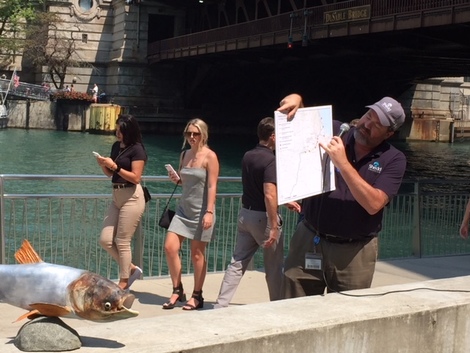3 Things About Asian Carp From Lunchtime Lecturer Andy Casper of Shedd Aquarium

Fish was on menu for the latest lunchtime lecture at our McCormick Bridgehouse & Chicago River Museum. Not to eat but to learn about. Specifically, Asian carp.
The August 13 guest for our weekly Monday event was Andy Casper, Director of Freshwater Research for the Shedd Aquarium. Asian carp, an invasive species brought to the American south in the 1970s to control nuisance algal blooms in wastewater treatment plants and aquaculture ponds, ended up in the Mississippi River, then the Illinois River after floods. Today, they are kept out of the Chicago River system by an electrical barrier near Joliet on Sanitary and Ship Canal and by government-supported commercial fishing.
Here are three things you may not know about Asian Carp from Casper’s lunchtime lecture.
- The most common Asian carp in Illinois is the Silver carp. They travel in schools and are sensitive to soundwaves that reverberate through the water. That’s why they jump when boats buzz by (as seen in a number of popular YouTube videos.) Though people have been injured by the leaping fish, they’re not attacking; they’re trying to escape what they think is a predator in the water, said Casper.
2. They suffer from a bad name. “When you say ‘carp,’ it doesn't sounds like ‘lunch,’” Casper said. Too bad: they are not bottom feeding fish and “actually taste very clean,” he said. They can be prepared so they have the consistency of pulled pork and are delicious in tacos or in a salad. Deep frying them for a sandwich “melts” their bones so eaters don’t detect them. Some people grill them like salmon, though the bones are more noticeable in that preparation technique. Mostly, Asian carp is sold in the United States as fertilizer or as pet food.
3. They produce like crazy: a typical female will create 100,000 to 300,000 eggs per year. Compare that to bass or blue gills which produce 50 to 100 eggs, he said. Even when conditions stress them, such as drought, they don't produce fewer Asian carp, he said. "They're just skinnier."

Our free lecture series are held on the museum's beautiful plaza on the Riverwalk at the southwest corner of Michigan Avenue and Wacker Drive. They start at 12:15 p.m. on Mondays and run about a half hour.
Here's what's coming up:
Monday, Aug. 20th: "Butterflies of the American Prairie" by Dr. Doug Taron, Chief Curator of the Chicago Academy of Sciences, Peggy Notebaert Nature Museum
Monday, Aug. 27th: "Art Along the River" by Linda Keane, Professor & Creative Director, School of the Art Institue of Chicago.

